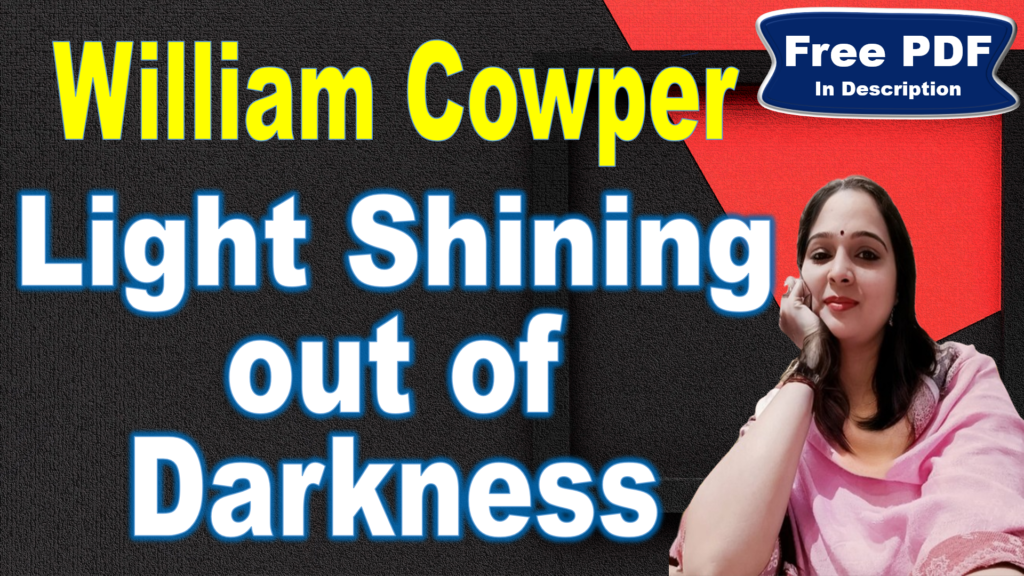
Light Shining out of Darkness Questions Answers
Very Short Answer Questions
Who wrote the poem?
William Cowper.
What is the rhyme scheme of the poem?
ABAB (quatrains).
Who is the speaker in the poem?
The poet himself, addressing God.
What is the central theme of the poem?
Trust in God’s providence even when His ways seem mysterious.
What is the tone of the poem?
Contemplative and hopeful.
What style elements does Cowper use?
Metaphors, paradoxes, and imagery.
What legacy did Cowper leave behind?
Impact on literature and hymnody.
Name one of Cowper’s notable works.
“The Task.”
What recurring theme appears in Cowper’s poetry?
Nature.
What deeply influences Cowper’s verses?
His Christian faith.
What literary form does the poem belong to?
A hymn.
What does the phrase “God moves in a mysterious way” imply?
God’s actions are beyond human comprehension.
What metaphor is used for God’s actions in Stanza 1?
“Footsteps in the sea.”
What encouragement does Stanza 3 offer?
To take fresh courage despite fears.
What does “blind unbelief” refer to in Stanza 6?
Doubting God’s goodness.
What paradox is presented in Stanza 4?
A frowning providence hides a smiling face.
What natural elements are mentioned in the poem?
Sea, storms, buds, and flowers.
What is the overall mood of the poem?
Reflective and hopeful.
Who co-authored the hymn collection “Olney Hymns”?
John Newton.
What legacy did Cowper leave in hymnody?
Lasting impact on Christian worship.
Short Answer Questions
What is the central theme of “Light Shining out of Darkness”?
The central theme is trust in God’s providence even when His ways seem mysterious. Cowper explores the idea that God’s actions, though often hidden, ultimately lead to blessings.
How does Cowper use paradox in the poem?
Cowper presents a paradox in Stanza 4: “Behind a frowning providence / He hides a smiling face.” This juxtaposition of a frown and a hidden smile reflects the tension between hardship and God’s benevolence.
Describe the imagery in the poem.
The poem evokes vivid images: God’s footsteps in the sea, riding upon storms. These images convey God’s power and mystery, emphasizing His control over natural forces.
What role does faith play in Cowper’s poem?
Faith is central. Despite life’s challenges (symbolized by storms), the speaker encourages trust in God’s providence. Faith transcends human understanding and sustains believers.
Why does Cowper refer to God’s actions as “wonders”?
The term “wonders” emphasizes the inconceivability and magnificence of God’s deeds. It underscores His sovereignty and the awe-inspiring nature of His ways.
Discuss the impact of Cowper’s personal struggles on the poem.
Cowper battled depression and mental health issues. His own experiences likely influenced the poem’s exploration of darkness, hope, and faith.
How does the sea symbolize God’s actions?
The sea represents mystery and depth. God’s footsteps planted there are hidden, just as His providence often eludes human understanding.
What message does the poem convey about adversity?
Adversity (the storm) may seem daunting, but it holds blessings. The bud’s bitterness eventually yields sweetness (the flower).
Why does Cowper describe God’s way as “mysterious”?
Cowper acknowledges the challenge of writing about God, who remains beyond empirical knowledge. The mystery underscores the limits of human understanding.
In what ways does Cowper’s poem resonate with readers today?
Cowper’s exploration of faith, providence, and hope speaks to universal human experiences. The tension between darkness and light remains relevant across cultures and time.





